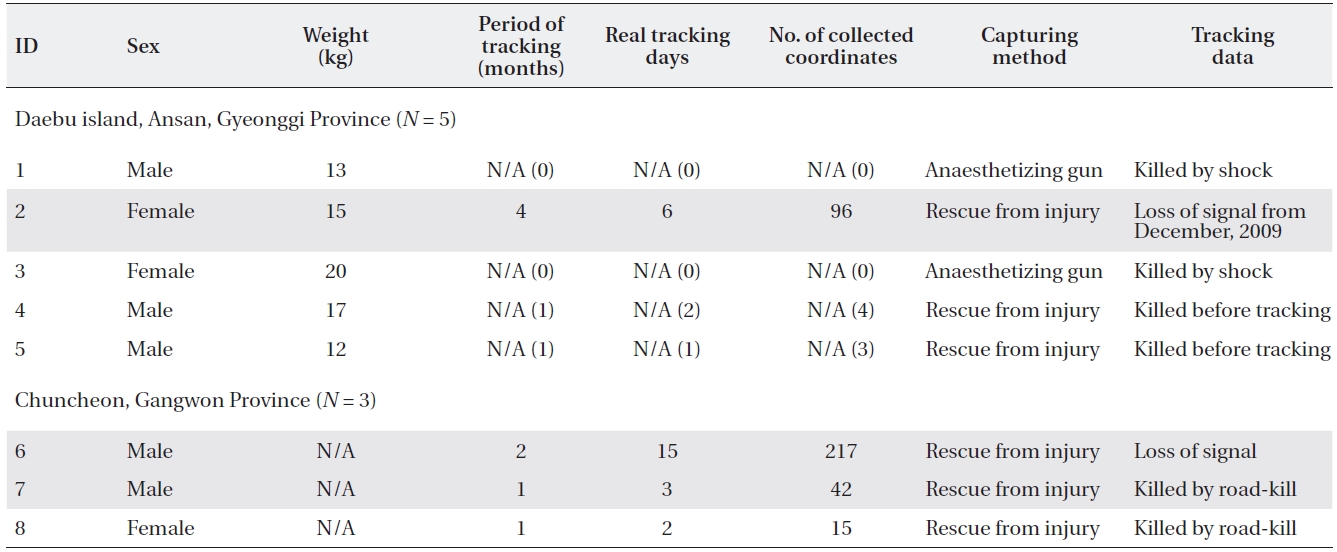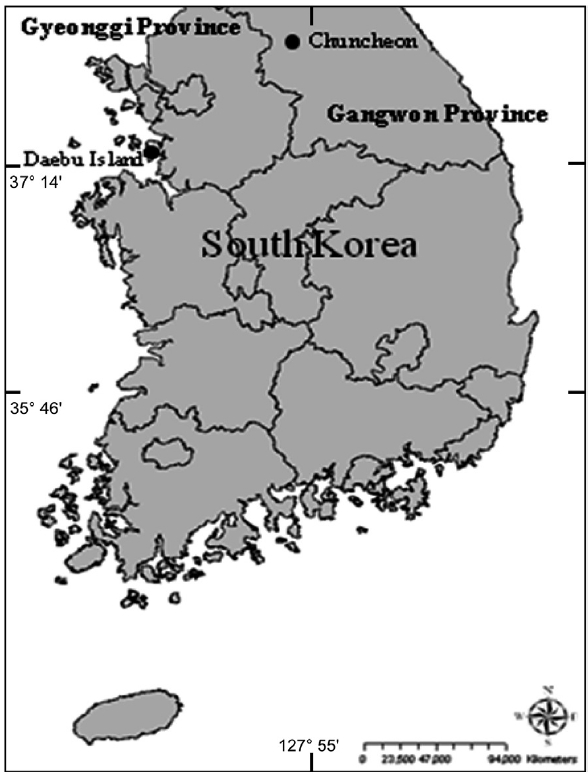



The water deer (
An individual’s home range, the area used by an ani-mal in its normal activities of food collection, mating, and raising its young (Burt 1943), is a fundamental piece of its ecology. To estimate home range size, both mini-mum convex polygons (MCP) and kernel (K) methods have been commonly used because they are easily com-pared among studies (Harris et al. 1990, White and Garrott 1990). The K method usually allows for the determination of the center of activity (Worton 1989, 1995, Seaman and Rowell 1996).
Home range sizes of the water deer have been reported in a few studies (Cooke and Farrell 1998). In China, mean seasonal home ranges varied from 18 (1.8 km2) to 46 ha (4.6 km2) in a population. Females established feeding sites and set up small territories of about half a hectare. In England, the mean annual home range size was 21 ha (2.1 km2) at Whipsnade. However, home range studies have not yet been conducted in Korea. Therefore, such studies are essential to understanding the ecology of the Korean water deer. The aim of the present study was to estimate home range sizes. Sex, time (6 AM-6 PM, day and night), and season were considered in the home range compari-son.
Two different study sites were targeted in the present study (Fig.1 ): one is Daebu Island, Ansan of Gyeonggi Province (126°34?30?-126°39?0? E, 37°15?0?-37°16?30? N), and the other is a rural area of Chuncheon, Gangwon Province (127°46?04?-127°45?23? E, 37°48?28?-37°47?50? N) in the central parts of the Korean peninsula. In the
former site, two different types of habitats were found, including a reclaimed area (lowland) and a mountainous area (highland). Dominant species in the reclaimed area included halophytes (e.g.,
In Ansan, a total of five individuals were captured using an anaesthetizing gun (
[Table 1.] Information on the Korean water deer (N = 8) captured in the present study

Information on the Korean water deer (N = 8) captured in the present study
ArcGIS9.3 computer software (ESRI Inc., San Diego, CA, USA) was used for the home range analyses. All data col-lected were analyzed to estimate the home range of the Korean water deer using the Home Range Tools (HRT) for ArcGIS9.x. For topographic maps, 1:5,000 maps from the National Geographic Information Institute (NGI, Seoul, Korea) were used. Both the 95% fixed MCP and the 50% fixed K methods were used to calculate home range sizes of the Korean water deer (Worton 1989, Harris et al. 1990, White and Garrott 1990, Worton 1995, Seaman and Rowell 1996). Tracking data of the four individuals were used to estimate home range sizes based on sex, time, or season.
In this study, we analyzed home range sizes of four individuals (the number of fixes for subject 2, 6, 7, and 8 were 96, 217, 42, and 15 GPS points, respectively) of the Korean water deer. The mean home range size of the four individuals was 2.77 km2 by 95% MCP and 0.34 km2 by 50% K (Table 1). There seemed to be a clear difference of home range size between the male (3.30 km2) and female (2.25 km2) using the MCP method but little difference of home range size between the male (0.23 km2) and fe-male (0.45 km2) using the K method (Table 2). For the 95% MCP method, we found a meaningful difference in home range size between day (6 AM-6 PM, 1.99 km2) and night (2.43km2) (Table 2). Also, a great difference in home range size of the Korean water deer was observed between summer (June-August, 4.65 km2) and spring (March-May, 0.48 km2) or fall (September-November, 0.85 km2) (Table 2). For the 50% K method, little difference in home range size was found between day (0.32 km2) and night (0.26 km2) or between summer (0.57 km2) and spring (0.14 km2) or fall (0.21 km2) (Table 2).
The home range size of the Korean water deer has been unavailable until now. All of the current studies used a radio collar to track each animal. GPS tracking using a cell phone collar has recently been used to track wild mammals worldwide. However, such a method has not yet been used in Korea. Therefore, it is necessary to ap-ply such a method using a GPS collar and a code division multiple access (CDMA) system for Korean wildlife track-ing. Here we mentioned our results using both radio and GPS tracking.
Based on our results, the Korean water deer showed a mean home range size similar to that of the Chinese wa-ter deer in China and England. In the present study, mean home range size (
In the wild, feeding activity of nocturnal mammals tends to be higher at night than during the day. For exam-ple, raccoon dog feeding areas differed largely between daytime (0.01 km2) and nighttime (0.35 km2 for 95% MCP) hours (Kim et al. 2008). The Korean water deer in the pres-ent study showed the same pattern. However, the Korean water deer moved somewhat more to feed during the daytime (1.90 km2), even though it moved much move ac-tively at night (2.43 km2 for 95% MCP). In fact, it seemed to spend its night-time hours mainly feeding by ruminating, whereas it spent its day-time hours both ruminating and resting. Based on our observations, the Korean water deer tended to move actively after dawn (500-700) and before
[Table 2.] Home range sizes (km2) of the Korean water deer by individual, sex, time and season

Home range sizes (km2) of the Korean water deer by individual, sex, time and season
sunset (1,700-1,900). The water deer usually moved to its feeding site(s) or its resting site(s) during those hours. Cooke and Farrell (1998) reported that Chinese water deer spend about half of their daytime hours feeding. The water deer also fed at night, but details of quantity have not yet been determined (Cooke and Farrell 1998). The feeding peaks occurred in the early morning and in the evening as seen in the present study.
To investigate the seasonal differences in home range sizes, we analyzed home range sizes using both radio tracking (
Finally, we analyzed the differences in home range size between females and males (Table 2). Based on our study, the female (2.25 km2 for 95% MCP) showed a smaller home range than the male (3.30 km2 for 95% MCP). Cooke and Farrell (1998) mentioned that home range size was largest for older females (about 1 km2) and second-year deer (about 1.5 km2) from late spring (May) to mid-sum-mer (July), whereas home range size was < 0.5 km2 for older males (> 2 years). Our results showed that the mean home range size of adult males (≥ 2 years) was larger than that of adult females (≥ 2 years), even though it is difficult to compare with previous results.
In conclusion, we first estimated home range size of the water deer using radio and GPS tracking in Korea. The Korean water deer appeared to have a home range of 0.2-6.4 km2, which is similar to that of the Chinese water deer in China and England. There were variations between day, night, seasons, and sexes seen in the present study. However, further extensive studies should be conducted to evaluate detailed home range sizes due to our limited data (e.g., the small number of individuals tracked and no tracking in the winter). We suspect that GPS tracking based on the CDMA system could be a very useful tool for understanding the ecology of the water deer using the ra-dio tracking method.


